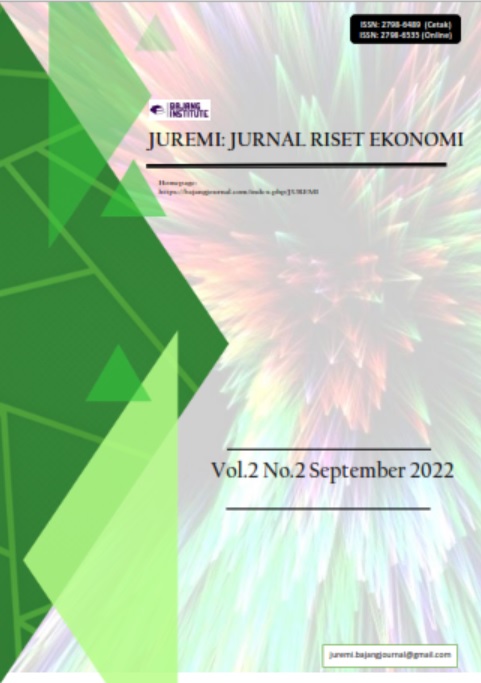ANALISIS PENGARUH ELECTRONIC MONEY TERHADAP JUMLAH UANG BEREDAR DAN VELOCITY OF MONEY DI INDONESIA
DOI:
https://doi.org/10.53625/juremi.v2i2.2839Keywords:
Electronic Money, Money Supply, Velocity of MoneyAbstract
The purpose of this study is to determine whether electronic money has an effect on the money
supply and velocity of money in Indonesia. Technological developments that are increasingly
developing affect payment systems that used to use cash to become e-money. E-money is starting
to develop and is in demand by the public because it is considered more efficient and effective.
The increasing use of electronic money (e-money) by the public has an impact on the money
supply (M1) in Indonesia and the velocity of money. This study uses a quantitative approach with
the type of associative research. This study uses secondary data sources. The sample in this study
is the value of the volume of electronic money, the value of the money supply and the value of the
velocity of money in Indonesia in 2012-2021. This study uses secondary data sources. The data
analysis method used in this research is simple linear regression analysis. The result of this
research is that e-money has a significant effect on the money supply. Electronic money contains
float funds that are highly liquid which can be used to make legal payment transactions. So when
the value of float funds increases, the amount of money in circulation in the community also
increases. Electronic money has a significant effect on the velocity of money, when many people
use e-money, fewer people use cash to make transactions.
References
Anggarini, D. T. (2016). Analisa Jumlah Uang Beredar di Indonesia Tahun 2005-2014.
Fatmawati, M. N. R. & I. Y. (2019). Pengaruh Transaksi Non Tunai Terhadap Jumlah Uang Beredar Di Indonesia Tahun 2015-2018 Dengan Inflasi. Jurnal Ekonomi, Keuangan, Perbankan Dan Akuntansi, 11(2).
Lintangsari, N. L. (2018). Analisis Pengaruh Instrumen Pembayaran Non-Tunai Terhadap Stabilitas Sistem Keuangan di Indonesia. Jurnal DINAMIKA Ekonomi Pembangunan, 1(1).
Igamo, A. M. & E. A. F. (2018). The Impact of Electronic Money on The Efficiency of The Payment System and The Substitution of Cash in Indonesia. Sriwijaya International Journal of Dynamic Economics and Business, 2(3).
Wijaya, Anggun Yuli & Imam Mukhlis, & L. S. (2021). Analisis Pengaruh E-Money, Volume Transaksi Elektronik dan Suku Bunga Terhadap Jumlah Uang Beredar di Indonesia Pada Masa Sebelum dan Sesudah Pandemi COVID-19. Jurnal Ekonomi, Bisnis Dan Pendidikan, 1(2).
Permatasari, K. & P. (2020). Pengaruh Pembayaran Non Tunai Terhadap Variabel Makro Ekonomi Di Indonesia Tahun 2010-2017. Jurnal Ilmu Manajemen, 8(1).
Kholidah, M. A. & N. (2020). Faktor-Faktor Yang Mempengaruhi Minat Mahasiswa Menggunakan Uang Elektronik Berbasis Server. PT. Nsya Expanding Management.
Suardi, M. & D. (2020). Pengantar Ekonomi Islam. CV Jakad Media Publishing.
Hidayati, Siti, et. al. (2006). Operasional E-Money. Bank Indonesia.
Indonesia, B. (2015). Surat Edaran Bank Indonesia No. 17/8/FBI tentang pengaturan dan pengawasan moneter. Bank Indonesia.
Muchtar, Bustari, R. R. & M. K. S. (2016). Bank Dan Lembaga Keuangan Lain. Kencana.
Hidayati, N. dan H. (2021). Manusia Indonesia, Alam dan Sekitarnya. K-Media.
Priowirjanto, E. S. (2021). Terminologi Ekonomi dan Teknologi Informasi. Bintang Pustaka Madani.
Fardiansyah, H. (2022). Ekonomi Moneter (Teori dan Kebijakan). CV. Media Sains Indonesia.
Mishkin, F. (2009). Ekonomi Uang, Perbankan dan Pasar Keuangan. Salemba Empat.
Rahmaniar, A. A. & D. N. A. (2021). E-Money Produk Domestic Bruto dan Inflasi Terhadap Perputaran Uang Studi Kaus Pada 3 Negara Di Asean. Economic Business Management dan Accounting Journal, 17(1).
Rahayu, S. & R. Y. Y. N. (2020). Dampak Pembayaran Non Tunai Terhadap Percepatan Perputanan Uang Di Indonesia. Jurnal Bisnis Dan Ekonomi Islam, 5(1).
Nisfiannor, M. (2009). Pendekatan Statistika Moderen untuk Ilmu Sosial. Salemba Humanika.
















